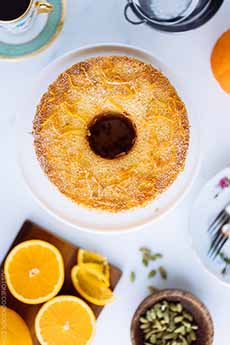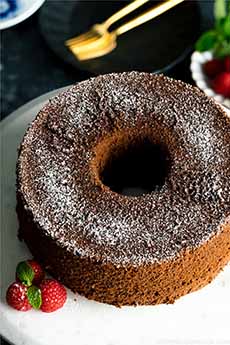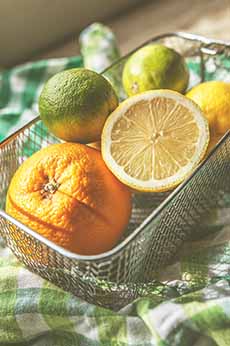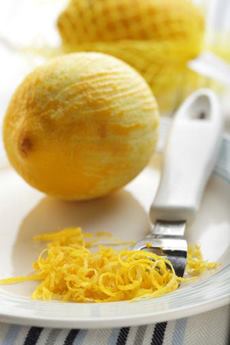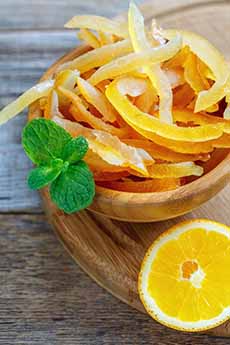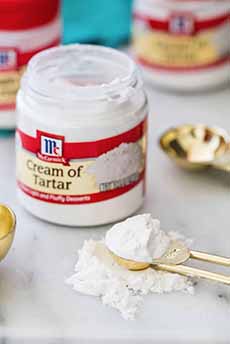A Recipe For Lemon Chiffon Cake Day & A Candied Peel Recipe
|
March 29th is National Lemon Chiffon Cake Day. A recipe that isn’t seen much anymore, it was a favorite of our mother’s. She baked them in a tube pan and garnished the light, lemony slices with sliced strawberries and whipped cream.
We prefer the lemon glaze and candied lemon peel in the recipe below. > The different types of cake: a glossary. According to General Mills, the chiffon cake, invented in 1927, was the first new cake to come along in 100 years. (One might dispute that—the brownie debuted within 30 years prior to it, although it is classified as a bar cookie and not cake. Digging through culinary history will no doubt produce other challengers.) The secret of this airy, fluffy cake are two: That egg whites are beaten separately from the yolks, and that the recipe uses vegetable oil instead of butter or conventional shortening. Using oil as the fat enables the cake to be refrigerated without hardening—and it was a breakthrough. Chiffon cake was invented by the aptly named Harry Baker (no irony), an Ohio insurance agent. His business had gone south in the slump of 1921 and he was broke (there was also a sex scandal that led to divorce—read the details here). At the age of 40, Baker moved to Hollywood, leaving his wife and children behind. Looking for a new occupation, he decided to make and sell his homemade fudge, selling enough to a high-end confectioner to make a living. He also began to tinker with cake recipes, making more than 400 different recipes in his quest to bake a sweeter, moister angel food cake. Nothing worked until he replaced the butter with vegetable oil—his “secret ingredient”—in the cake recipe (recipe below). The cake was called chiffon for its weightlessness. He brought samples to the Brown Derby restaurant on Wilshire Boulevard, which became a customer. After the Cobb Salad, it became the restaurant’s most popular dish. He also created a version with grapefruit replacing the lemon, at the demand of Louella Parsons. Stars such as Dolores del Rio, Nelson Eddy, Lily Pons, and Barbara Stanwyck ordered cakes for their parties. The studio commissaries followed suit. When the Brown Derby opened an outpost near Paramount Studios, it was mobbed by movie stars who wanted the cake: Claudette Colbert, Clark Gable, and Tyrone Power, among others (diets be damned?). First Lady Eleanor Roosevelt tasted the cake at a Los Angeles party she attended with Will Rogers. Shortly after, Baker was invited to the White House to share his recipe with the staff. Baker sent a cake but declined that invitation, along with hundreds of other requests for his recipe. He took elaborate precautions to guard his recipe, mixing the batter alone in the kitchen of his bungalow on Larchmont Boulevard. Not only was no one was allowed in his kitchen, but he also hid his garbage, fearing that spies would see the high volume of used vegetable oil containers and guess his secret ingredient. Throughout the 1930s, orders for the chiffon cake came in faster than Baker could make them. He mixed batter for each cake individually and baked them separately, using twelve tin hot-plate ovens he set up in a spare bedroom. Finished cakes were set to cool on his porch, where customers could pick them up, leaving the two dollars’ payment in the mail slot— the equivalent of around $45 today [source]. At the peak of his business, Baker produced 42 cakes in an 18-hour day, from which he grossed the equivalent, in today’s dollars, of around $900. [source] In 1947, Baker sold the recipe to General Mills—some say for $25,000, some say for $50,000, although the exact amount was never divulged. It was a secret no more. Chiffon cake created a sensation when it was published in the May 1948 issue of Better Homes and Gardens magazine. Today, in the U.S., the trend has long cooled and the chiffon cake is considered “retro.” But in Asia, its lightness has made it very popular from Japan to Singapore. If you visit, you can eat more than your fill. Before Baker, another man, Morton Boston Strause, created the chiffon pie. Here’s more about him and a detailed article on how he became the “pie engineer.” For this recipe, you’ll need a 7-inch tube pan. The recipes for the lemon zest glaze and the candied lemon peel follow. Ingredients *Use regular cake flour, not self-rising flour. Preparation 1. PREHEAT the oven to 325°F 2. SIFT together the flour, baking soda, salt, and 3/4 cup sugar. Set aside. 3. WHISK together the egg yolks, vegetable oil, 1/3 cup water, lemon juice, lemon zest, and vanilla. Add to the sifted dry ingredients; beat until smooth. 4. BEAT the egg whites in the bowl of an electric mixer on medium speed, until foamy. Add cream of tartar and beat on high speed until soft peaks form, about 1 minute. 5. ADD gradually the remaining tablespoon of sugar; beat on high speed until stiff peaks form, about 2 minutes. 6. FOLD egg-white mixture into the batter slowly, 1/3 at a time. Add batter to an ungreased tube pan. Using an offset spatula, smooth the top. Bake until a cake tester inserted in the middle comes out clean and the cake is golden, about 45 minutes. 7. REMOVE cake from the oven. Invert the pan over a wine bottle for 2 hours to cool. Remove and run a knife between the cake and the pan; invert again, and remove the cake. 8. GARNISH as desired: Dust the plain cake with confectioners’ sugar before serving, or serve with whipped cream. We like to drizzle the cake with the lemon zest glaze below. Ingredients 1. COMBINE the ingredients in a small bowl and stir until well blended. 2. DRIZZLE over the top of the cooled cake. Ingredients 1. WASH lemons, pat dry, and remove the fruit pulp and as much of the white pith as you can. Cut peel into slices 1/4 inch wide. 2. BOIL water in a small pan; add peel strips. Boil for 5 minutes, until tender. 3. REMOVE peels from water and whisk in the sugar until dissolved. Return water to a boil; add peels and boil until syrup absorbs into the peel. 4. DRAIN cooked peel on paper towels. After they dry, you can store them in an airtight jar for a week. You can also use this recipe for candied grapefruit and orange peel. If you’re a baker, you’ve likely been using cream of tartar since your first forays. Angel food cake, biscuits, chiffon cake, crystallized candy, lemon meringue pie, meringues and other cookies, and many other recipes require it. Technically, it’s a chemical compound, potassium bitartrate, also known as potassium hydrogen tartrate (for you chemistry majors, the formula is KC₄H₅O₆). In cooking, it is known as cream of tartar.
|
|
|
|
It’s a byproduct of wine making, processed from the potassium acid salt of tartaric acid. Tartaric acid occurs naturally in grapes and is the main type of acid that you taste in wine (especially white wine).
Cream of tartar is a powder of tartaric acid mixed with potassium hydroxide, a.k.a. potash†, and therefore is less acidic than straight tartaric acid. Why do we use it? When paired with baking soda, cream of tartar gives baked goods their rise. It’s a volumizer and also a tenderizer. Plus: And it’s combined with potassium chloride in sodium-free salt substitutes. Fun Facts †Potassium hydroxide, an inorganic compound denoted by the chemical formula KOH, an alkali metal hydroxide and a strong base. Caustic potash, potash lye, and lye are all names for potassium hydroxide. | ||

